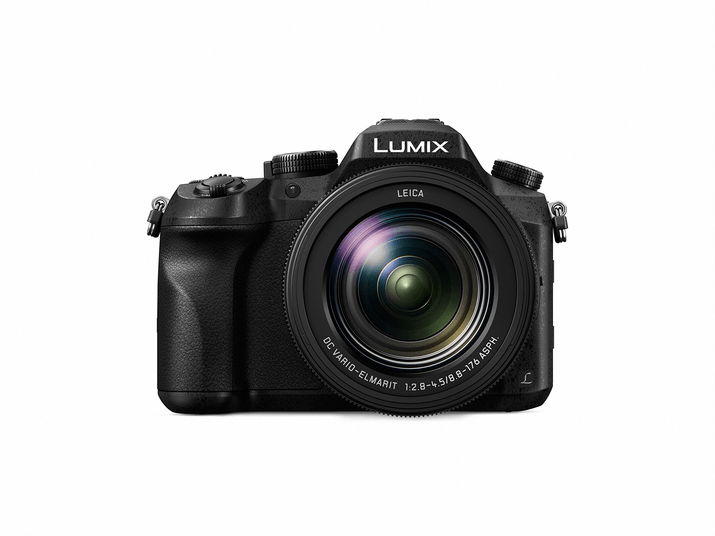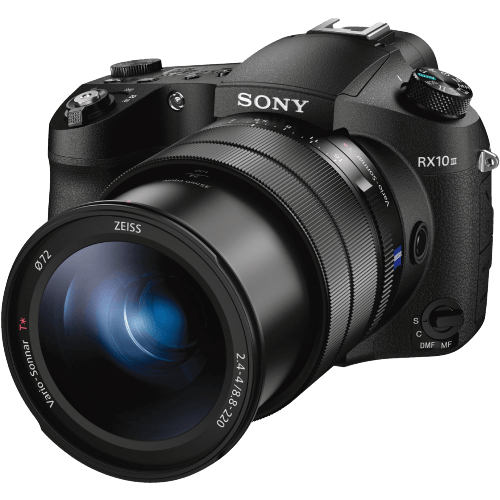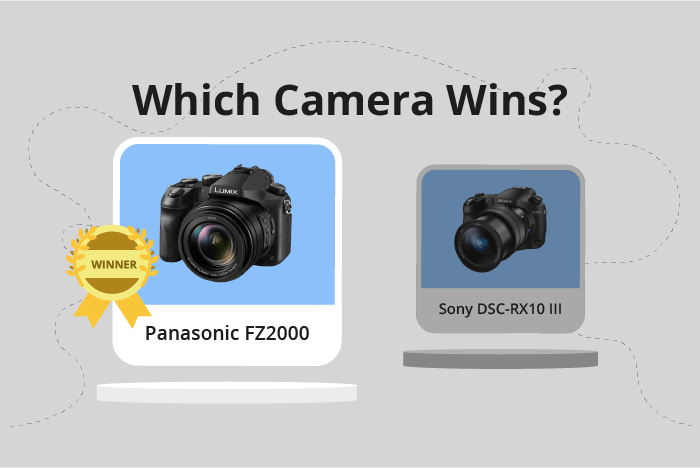Panasonic Lumix DMC-FZ2000 / FZ2500 vs Sony Cyber-shot DSC-RX10 III Comparison
Panasonic Lumix DMC-FZ2000 / FZ2500

Sony Cyber-shot DSC-RX10 III

The Panasonic Lumix DMC-FZ2000 / FZ2500 and the Sony Cyber-shot DSC-RX10 III are both Bridge cameras with a score of 63/100. Released in 2016, these cameras share similarities in their launch prices, with the Panasonic at $1199 and the Sony at $1499.
One advantage of the Panasonic Lumix DMC-FZ2000 / FZ2500 is its lighter weight of 915g (2.02lbs), compared to the Sony Cyber-shot DSC-RX10 III’s 1051g (2.32lbs). This makes the Panasonic camera easier to carry around. However, the Sony camera is more compact, measuring 133 x 94 x 127mm, while the Panasonic camera has dimensions of 138 x 102 x 135mm.
Considering the similarities in their specifications and scores, both cameras offer great performance, with the Panasonic Lumix DMC-FZ2000 / FZ2500 being ideal for those seeking a lighter camera and the Sony Cyber-shot DSC-RX10 III for those who prefer a more compact design.
Panasonic Lumix DMC-FZ2000 / FZ2500 vs Sony Cyber-shot DSC-RX10 III Overview and Optics
The Sony Cyber-shot DSC-RX10 III wins the optics comparison with a score of 63/100, just one point ahead of the Panasonic Lumix DMC-FZ2000 / FZ2500 (62/100). Both cameras share several specifications, such as 20 megapixels, a 1″ CMOS sensor, fixed lens mount, and image stabilization. They also have the same DXOMARK score for the sensor at 70.
The winning camera, the Sony RX10 III, offers a faster shooting speed of 14 frames per second compared to the Panasonic FZ2000 / FZ2500’s 12 fps. This advantage allows the Sony camera to capture fast-moving subjects more effectively. Additionally, the Sony camera has a Bionz X processor, which provides better image processing than the Panasonic’s Venus Engine.
Despite its lower score, the Panasonic FZ2000 / FZ2500 has some benefits over the Sony RX10 III. It is important to consider these advantages depending on your specific photography needs. However, the provided specs do not show any specific advantages for the Panasonic camera over the Sony camera.
Taking into account the scores and specifications, the Sony Cyber-shot DSC-RX10 III slightly outperforms the Panasonic Lumix DMC-FZ2000 / FZ2500 in terms of optics. The faster shooting speed and better image processing make it a better choice for those looking to capture fast-moving subjects. However, both cameras share many similarities, so the choice ultimately depends on the individual photographer’s preferences and requirements.
Panasonic Lumix DMC-FZ2000 / FZ2500 vs Sony Cyber-shot DSC-RX10 III Video Performance
The Panasonic Lumix DMC-FZ2000 / FZ2500 outperforms the Sony Cyber-shot DSC-RX10 III in video capabilities, scoring 69/100 compared to Sony’s 64/100. Both cameras share some common specifications, such as the absence of built-in time-lapse functionality. However, the Panasonic FZ2000 / FZ2500 offers superior video quality and features, making it the better choice for videographers.
The Panasonic Lumix DMC-FZ2000 / FZ2500 boasts a maximum video resolution of 4K, with dimensions of 4096 x 2160. This is significantly higher than the Sony Cyber-shot DSC-RX10 III, which only offers Full HD resolution at 1920 x 1080. The higher resolution of the Panasonic camera provides greater detail and clarity in video recordings, making it a more suitable choice for professional projects.
Additionally, the Panasonic FZ2000 / FZ2500 features a maximum video frame rate of 60fps, allowing for smooth motion capture. Despite having a lower overall video score, the Sony DSC-RX10 III does have a higher maximum video frame rate of 120fps. This higher frame rate can be useful for slow-motion video capture, giving the Sony camera a slight advantage in that specific area.
Taking these factors into account, the Panasonic Lumix DMC-FZ2000 / FZ2500 is the superior choice for video capabilities, offering higher resolution and overall better performance. The Sony Cyber-shot DSC-RX10 III does have a higher maximum frame rate, but the difference in video resolution makes the Panasonic camera more suitable for a wider range of applications.
Panasonic Lumix DMC-FZ2000 / FZ2500 vs Sony Cyber-shot DSC-RX10 III Features and Benefits
The Panasonic Lumix DMC-FZ2000 / FZ2500 and the Sony Cyber-shot DSC-RX10 III both have a feature score of 70/100, making them equally matched in terms of features. They share several specifications, including a 3-inch screen size, touchscreen capability, flip screen functionality, lack of GPS, and WiFi connectivity.
The Panasonic Lumix DMC-FZ2000 / FZ2500 has an advantage over the Sony Cyber-shot DSC-RX10 III in terms of Bluetooth connectivity, as it comes with built-in Bluetooth. This feature allows for easy and seamless sharing of photos and videos with compatible devices, making it more convenient for users.
On the other hand, the Sony Cyber-shot DSC-RX10 III has a higher screen resolution of 1,228,800 dots compared to the Panasonic Lumix DMC-FZ2000 / FZ2500’s 1,040,000 dots. This means that the Sony camera’s screen can display images with more clarity and detail, giving users a better view of their captured photos and videos.
In terms of features, there is no clear winner between the Panasonic Lumix DMC-FZ2000 / FZ2500 and the Sony Cyber-shot DSC-RX10 III, as they both have their strengths and weaknesses. The Panasonic camera offers Bluetooth connectivity, while the Sony camera boasts a higher screen resolution. Users should consider their specific needs and preferences when choosing between these two cameras, as both offer unique advantages.
Panasonic Lumix DMC-FZ2000 / FZ2500 vs Sony Cyber-shot DSC-RX10 III Storage and Battery
The Panasonic Lumix DMC-FZ2000 / FZ2500 outperforms the Sony Cyber-shot DSC-RX10 III in storage and battery with a score of 35/100 compared to Sony’s 24/100. Both cameras have one memory card slot and accept SD, SDHC, and SDXC cards. However, the Sony also accommodates Memory Stick Duo, Pro Duo, and Pro-HG Duo cards.
The Panasonic camera has a battery life of 350 shots using a DMW-BLC12 battery and offers USB charging, while the Sony camera provides a slightly longer battery life of 420 shots with an NP-FW50 battery but lacks USB charging capabilities. Although the Sony camera has a longer battery life, the Panasonic camera’s USB charging feature makes it more convenient for on-the-go charging.
In terms of storage and battery, the Panasonic Lumix DMC-FZ2000 / FZ2500 offers better overall convenience with USB charging, despite its slightly shorter battery life. The Sony Cyber-shot DSC-RX10 III’s additional memory card compatibility and longer battery life are notable, but the lack of USB charging can be a drawback for some users.
Alternatives to the Panasonic Lumix DMC-FZ2000 / FZ2500 and Sony Cyber-shot DSC-RX10 III
Are you still undecided about which camera is right for you? Have a look at these popular comparisons that feature the Panasonic Lumix DMC-FZ2000 / FZ2500 or the Sony Cyber-shot DSC-RX10 III:
- Panasonic Lumix DMC-FZ1000 II vs Lumix DMC-FZ2000 / FZ2500
- Panasonic Lumix DMC-FZ2000 / FZ2500 vs Lumix FZ80 / FZ82
- Sony Cyber-shot DSC-RX10 III vs Cyber-shot RX10 IV
- Panasonic Lumix DMC-FZ2000 / FZ2500 vs Lumix FZ300 / FZ330
- Canon PowerShot SX70 HS vs Panasonic Lumix DMC-FZ2000 / FZ2500
- Nikon Coolpix P950 vs Panasonic Lumix DMC-FZ2000 / FZ2500

